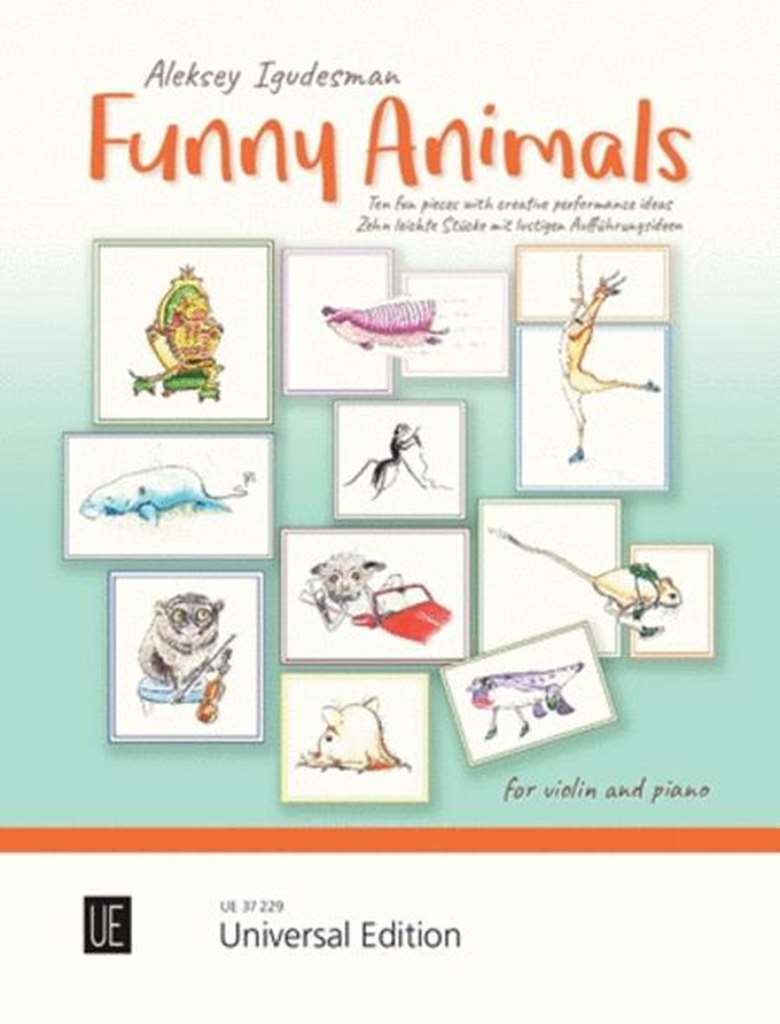Violin sheet music reviews
Helena Ruinard
Saturday, February 1, 2020
Helena Ruinard reviews Funny Animals for Violin and Piano by Aleksey Igudesman, published by Universal Editions and Six Sonata Progressives for Violin and Piano, Vols 1 and 2 by Carl Maria von Weber, published by Schott Music.

Funny Animals for Violin and Piano
First there was The Catscratch Book, Pigs Can Fly and A Fishsummer Night's Dream followed by In the Zoo and In the Zoo 2, all by Igudesman and published by Universal Edition. How to follow on from all this animal fun and perhaps even top it? ‘Easy’ says Igudesman in his introduction: ‘by discovering animals most people don't even know about and writing music inspired by them.’ Thus we have 10 pieces, each based on an animal, such as the pink fairy armadillo, the aye-aye (a long-fingered bat) or the red-lipped batfish.
The accompanying poems and illustrations set the tone for each piece, and then it is up to the performer to decide just how overtly to play and carry out the theatrical instructions suggested by the composer. With some animals, less is probably more; for example, the lugubrious music for the dugong only requires a little yawning in the direction of the audience, whereas the jerboa is all about pizzicato glissandi and leaping.
A child of nine or ten could really get involved with these pieces (as could a childlike player of 29, 39 or 79) if the teacher is sold on them and the environment is supportive and open-minded. The pieces are mainly in first position, but in order to manage the chromatic writing the player would need a knowledge of the fingerboard and general technique and musical knowledge of at least Grade 3 level. Character is so often left until last in teaching. Perhaps these fantastical, ridiculous pieces – based on true life and therefore even funnier – are just what we need to set that right.
Six Sonata Progressives for Violin and Piano, Vols 1 and 2
Yes, you read right: violin sonatas by Weber. This smart and ambitious young musician found himself needing to make money fast when in 1810 he and his father were excommunicated from Wurttemberg, where they had been working for the royal family. His father had evidently been close to Duke Louis, younger brother of the King of Wurttemberg, but was accused of misappropriating a large amount of his money. Needing a fresh start and to clear a mountain of personal debt built up because of his lavish lifestyle, Carl Maria arrived in Mannheim at the end of February 1810 and launched himself into giving concerts and writing music.
He had already held a post as director of the opera in Breslau and had had compositions published since the age of 12. Through his mentor, Abbé Vogler, he met the publisher Johann Anton Andre at the end of June 1810, and they discussed what amounted to commissions for a first symphony, a first piano concerto and these six sonatas. As the editor suggests in the preface, the sonatas were written to order and were typical of the ‘sophisticated literature originating at this time for private middle-class practice’. Weber appears to have produced them in the space of a few weeks that autumn, probably under the watchful eye of Vogler with whom he was staying, and they are full of invention within short and simple forms.
The piano part and violin part both require good knowledge and facility, approximating to at least today's Grade 7 standard, so that Andre ended up rejecting the works as they were ‘too good’ and too demanding. A few months later they were picked up by Simrock and must have been reasonably popular as Weber reports seeing copies before Simrock had sent him anything in the way of proofs.
Weber uses all the tools at his disposal to make these pieces appealing and varied, with operatic flourishes in the keyboard part (intended for a hammerklavier) and aria-like melodies shared between the two instruments; plenty of chromatic inflections; pizzicato and chords in the violin part, and one slow movement in which the cantabile melody is sustained the whole way through in the treble of the piano part with only the simplest of minim/semibreve accompaniments in the bass. The violin then fills out the texture with broken chords and passing notes. There are polonaises, siciliennes, polkas and one movement in the first set entitled ‘Carattere Espagnuolo’ which is followed by an ‘Air Russe.’ These sit alongside the expected allegros, andantes and rondos which, while classical in scope, contain just as much colour as the dance movements.
This edition has been carefully prepared from the urtext by Claudia Theis, and violinist Volker Worlitsch, who leads the NDR Symphony Orchestra in Hamburg, has done a wonderful job providing fingerings and bowings which bring to life the articulation suggested by the composer and editor.

